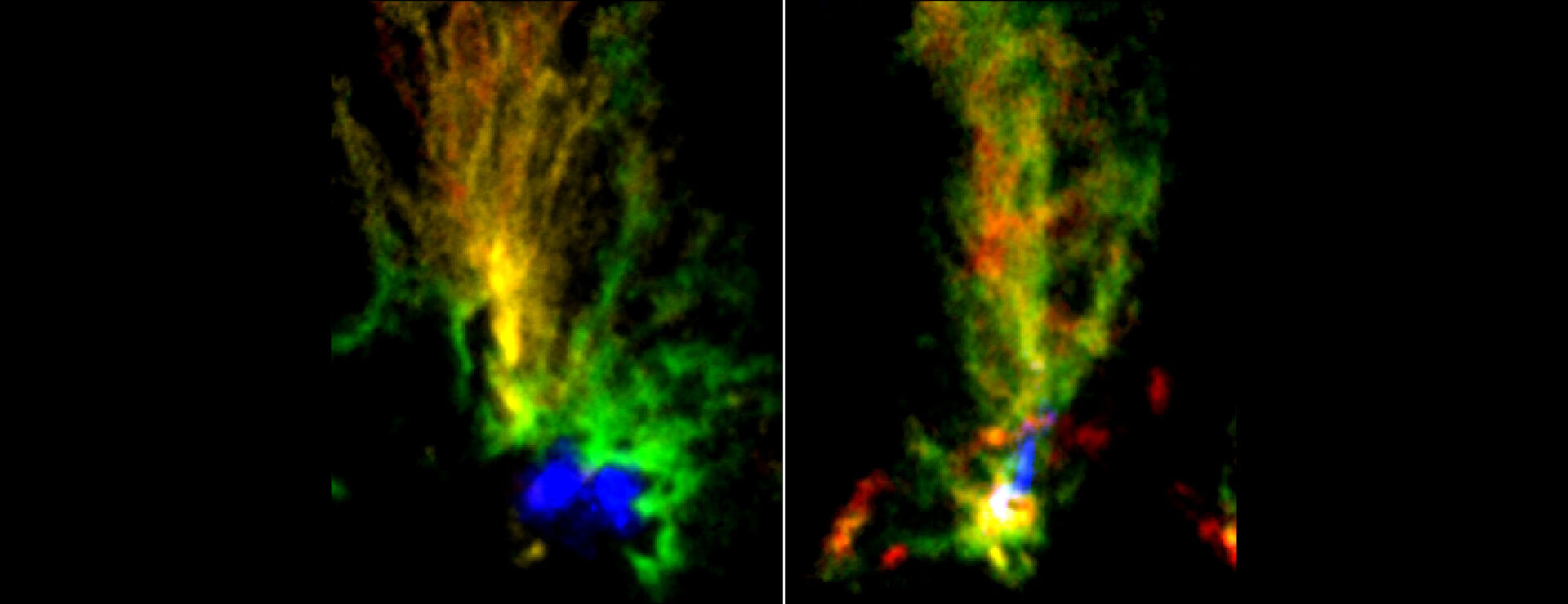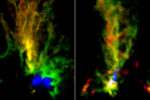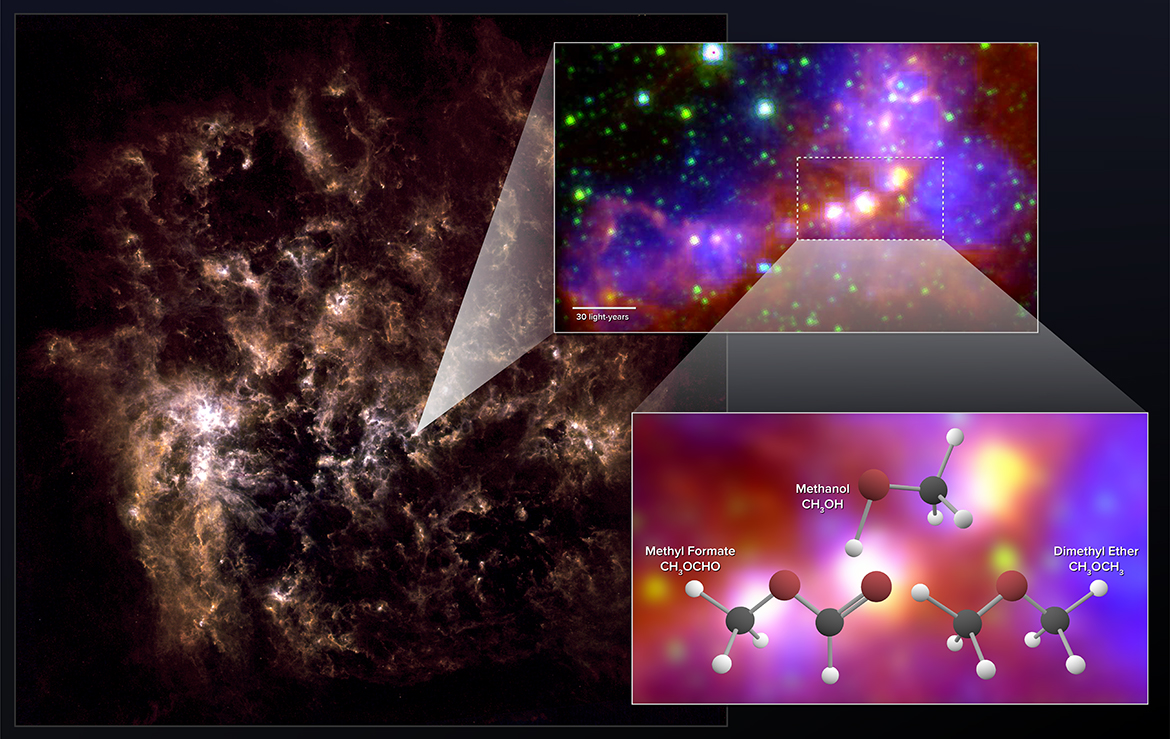Two Cosmic Peacocks Show Violent History of the Magellanic Clouds
Two peacock-shaped gas clouds were revealed in the Large Magellanic Cloud (LMC) by observations with the Atacama Large Millimeter/submillimeter Array (ALMA). A team of astronomers found several massive baby stars in the complex filamentary clouds, which agrees well with computer simulations of giant collisions of gas clouds. The researchers interpret this to mean that the filaments and young stars are telltale evidence of violent interactions between the LMC and the Small Magellanic Cloud (SMC) 200 million years ago.
Astronomers know that stars are formed in collapsing clouds in space. However, the formation processes of giant stars, 10 times or more massive than the Sun, are not well understood because it is difficult to pack such a large amount of material into a small region. Some researchers suggest that interactions between galaxies provide a perfect environment for massive star formation. Due to the colossal gravity, clouds in the galaxies are stirred, stretched, and often collide with each other. A huge amount of gas is compressed in an unusually small area, which could form the seeds of massive stars.
A research team used ALMA to study the structure of dense gas in N159, a bustling star formation region in the LMC. Thanks to ALMA’s high resolution, the team obtained a very detailed map of the clouds in two sub-regions, N159E-Papillon Nebula and N159W South.
Interestingly, the cloud structures in the two regions look very similar: fan-shaped filaments of gas extending to the north with the pivots in the southernmost points. The ALMA observations also found several massive baby stars in the filaments in the two regions.
“It is unnatural that in two regions separated by 150 light-years, clouds with such similar shapes were formed and that the ages of the baby stars are similar in two regions separated 150 light years,” says Kazuki Tokuda, a researcher at Osaka Prefecture University and the National Astronomical Observatory of Japan. “There must be a common cause of these features. Interaction between the LMC and SMC is a good candidate.”
In 2017, Yasuo Fukui, a professor at Nagoya University and his team revealed the motion of hydrogen gas in the LMC and found that a gaseous component right next to N159 has a different velocity than the rest of the clouds. They suggested a hypothesis that the starburst is caused by a massive flow of gas from the SMC to the LMC, and that this flow originated from a close encounter between the two galaxies 200 million years ago.
The pair of the peacock-shaped clouds in the two regions revealed by ALMA fits nicely with this hypothesis. Computer simulations show that many filamentary structures are formed in a short time scale after a collision of two clouds, which also backs this idea.
“For the first time, we uncovered the link between massive star formation and galaxy interactions in very sharp detail,” says Fukui, the lead author of one of the research papers. “This is an important step in understanding the formation process of massive star clusters in which galaxy interactions have a big impact.”
Additional Information
This research was presented in the following two papers on 14 November 2019 in the Astrophysical Journal.
- Fukui et al. “An ALMA view of molecular filaments in the Large Magellanic Cloud I: The formation of high-mass stars and pillars in the N159E-Papillon Nebula triggered by a cloud-cloud collision”
- Tokuda et al. “An ALMA view of molecular filaments in the Large Magellanic Cloud II: An early stage of high-mass star formation embedded at colliding clouds in N159W-South”
Research team members are:
Yasuo Fukui (Nagoya University), Kazuki Tokuda (Osaka Prefecture University/National Astronomical Observatory of Japan), Kazuya Saigo (National Astronomical Observatory of Japan), Ryohei Harada (Osaka Prefecture University), Kengo Tachihara (Nagoya University), Kisetsu Tsuge (Nagoya University), Tsuyoshi Inoue (Nagoya University), Kazufumi Torii (National Astronomical Observatory of Japan), Atsushi Nishimura (Nagoya University), Sarolta Zahorecz (Osaka Prefecture University/National Astronomical Observatory of Japan), Omnarayani Nayak (Space Telescope Science Institute), Margaret Meixner (Johns Hopkins University/Space Telescope Science Institute), Tetsuhiro Minamidani (National Astronomical Observatory of Japan), Akiko Kawamura (National Astronomical Observatory of Japan), Norikazu Mizuno (National Astronomical Observatory of Japan/Joint ALMA Observatory), Remy Indebetouw (University of Virginia/National Radio Astronomy Observatory), Marta Sewiło (NASA Goddard Space Flight Center/University of Maryland), Suzanne Madden (Université Paris-Saclay), Maud Galametz(Université Paris-Saclay), Vianney Lebouteiller (Université Paris-Saclay), C.-H. Rosie Chen (Max Planck Institute for Radio Astronomy), and Toshikazu Onishi (Osaka Prefecture University)
This research was supported by JSPS KAKENHI (No. 22244014, 23403001, 26247026, 18K13582, 18K13580,18H05440), NAOJ ALMA Scientific Research Grant (No. 2016-03B), and NASA (No.80GSFC17M0002).
The Atacama Large Millimeter/submillimeter Array (ALMA), an international astronomy facility, is a partnership of the European Organisation for Astronomical Research in the Southern Hemisphere (ESO), the U.S. National Science Foundation (NSF) and the National Institutes of Natural Sciences (NINS) of Japan in cooperation with the Republic of Chile. ALMA is funded by ESO on behalf of its Member States, by NSF in cooperation with the National Research Council of Canada (NRC) and the Ministry of Science and Technology (MOST) and by NINS in cooperation with the Academia Sinica (AS) in Taiwan and the Korea Astronomy and Space Science Institute (KASI).
ALMA construction and operations are led by ESO on behalf of its Member States; by the National Radio Astronomy Observatory (NRAO), managed by Associated Universities, Inc. (AUI), on behalf of North America; and by the National Astronomical Observatory of Japan (NAOJ) on behalf of East Asia. The Joint ALMA Observatory (JAO) provides the unified leadership and management of the construction, commissioning, and operation of ALMA.
Images and Video
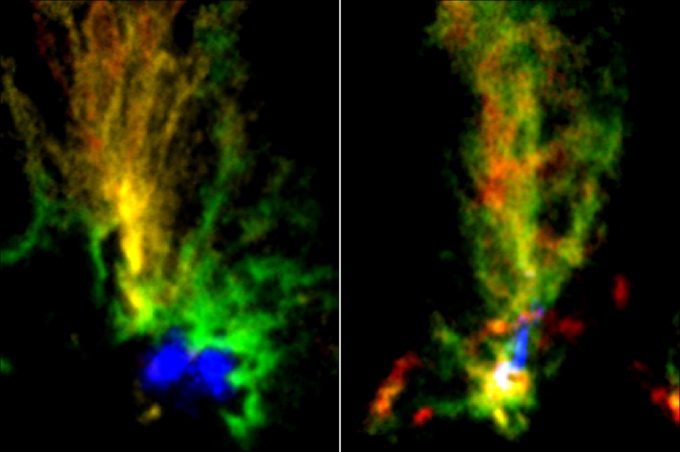
ALMA images of two molecular clouds N159E-Papillon Nebula (left) and N159W South (right). Red and green show the distribution of molecular gas in different velocities seen in the emission from 13CO. Blue region in N159E-Papillon Nebula shows the ionized hydrogen gas observed with the Hubble Space Telescope. Blue part in N159W South shows the emission from dust particles obtained with ALMA. Credit: ALMA (ESO/NAOJ/NRAO)/Fukui et al./Tokuda et al./NASA-ESA Hubble Space Telescope
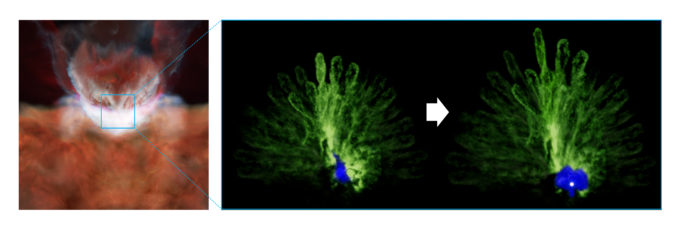
Artist’s impression of the formation process of peacock-shaped clouds. After collision of two clouds (left), complicated filamentary structures with a pivot in the bottom are formed in the boundary region (center), and a massive star is formed in the dense part with ionized region shown in blue (right). Credit: NAOJ
Computer simulation movie of collision of two gaseous clouds by Tsuyoshi Inoue (Nagoya University). A number of filamentary structures are formed at the same time after the collision. This simulation was performed by a supercomputer “ATERUI” operated by National Astronomical Observatory of Japan. Credit: NAOJ/Inoue et al.
Contacts
-
Nicolás Lira
Education and Public Outreach CoordinatorJoint ALMA Observatory, Santiago - ChilePhone: +56 2 2467 6519Cel: +56 9 9445 7726Email: [email protected] -
Masaaki Hiramatsu
Education and Public Outreach Officer, NAOJ Chile -
Iris Nijman
News and Public Information ManagerNational Radio Astronomy Observatory Charlottesville, Virginia - USACel: +1 (434) 249 3423Email: [email protected] -
Bárbara Ferreira
ESO Media Manager
